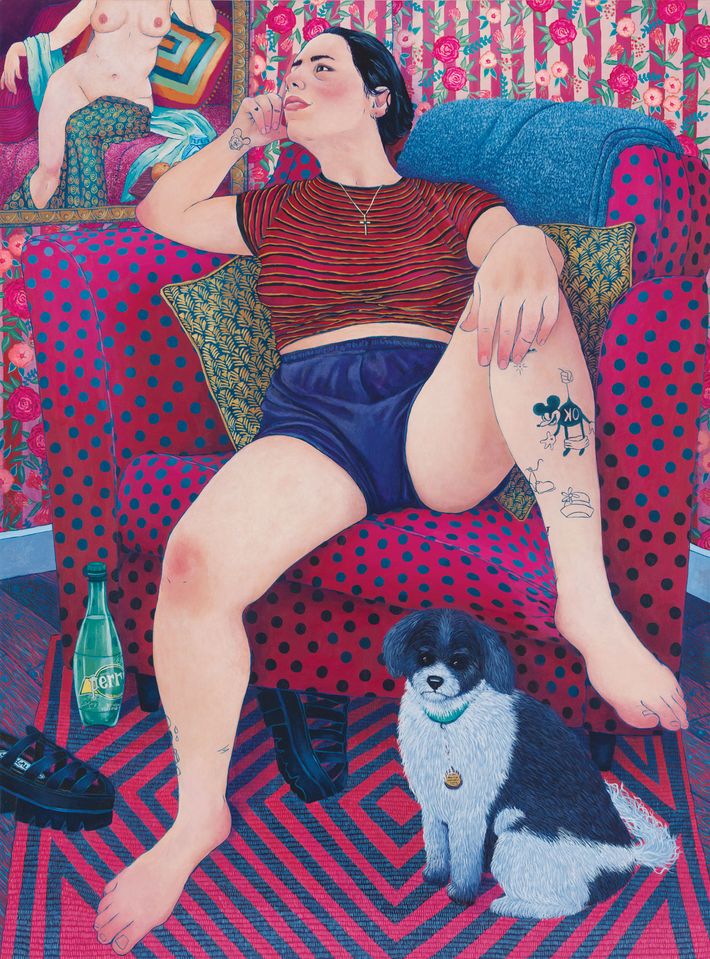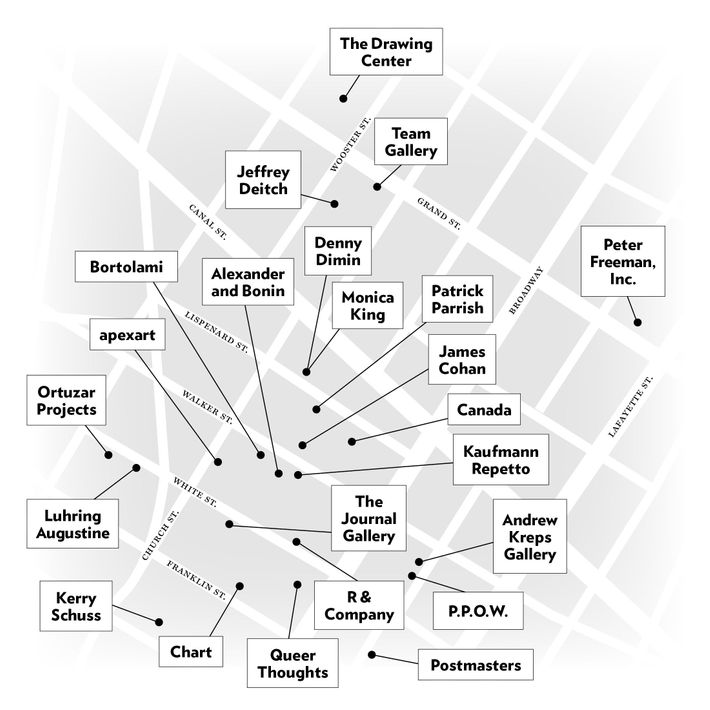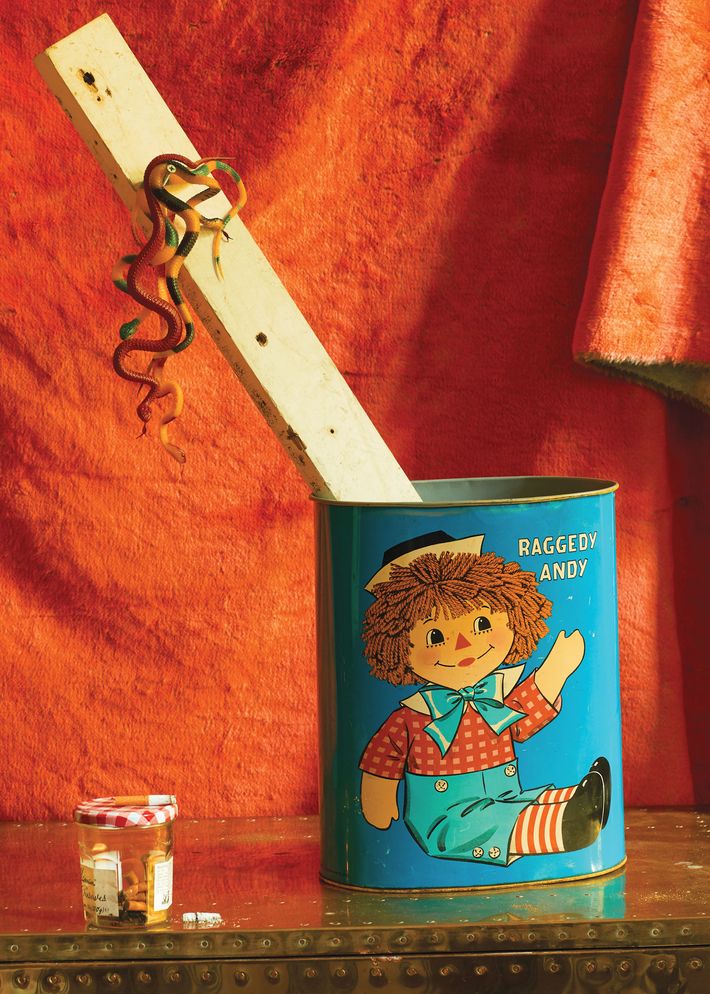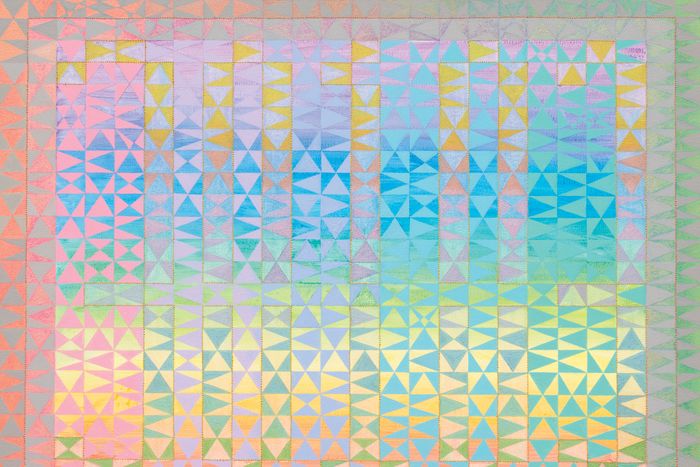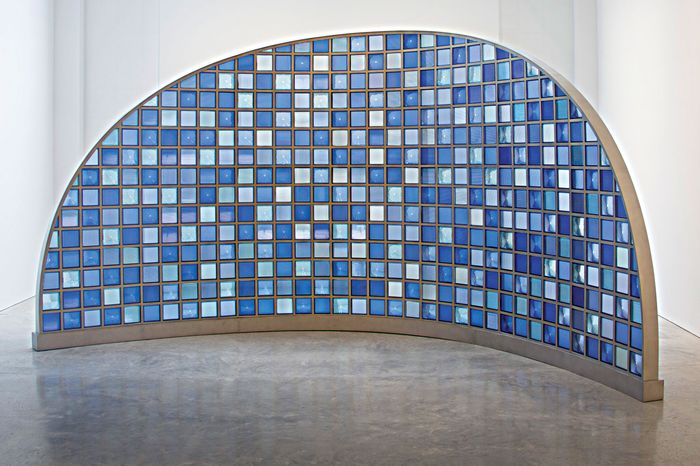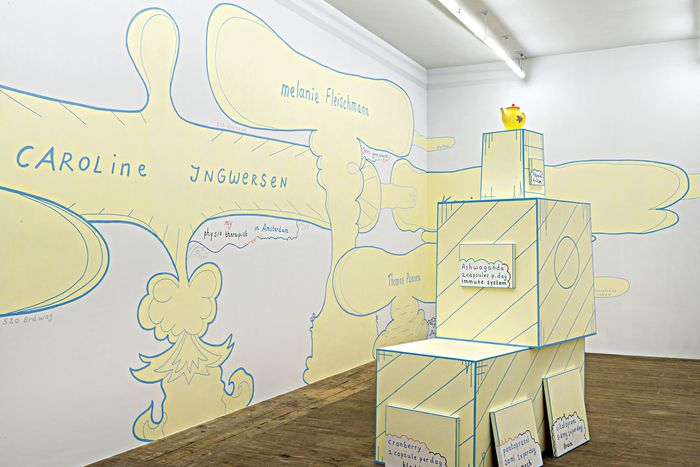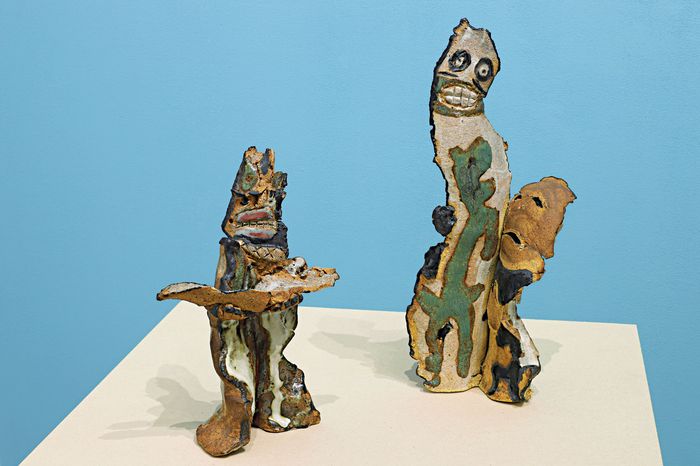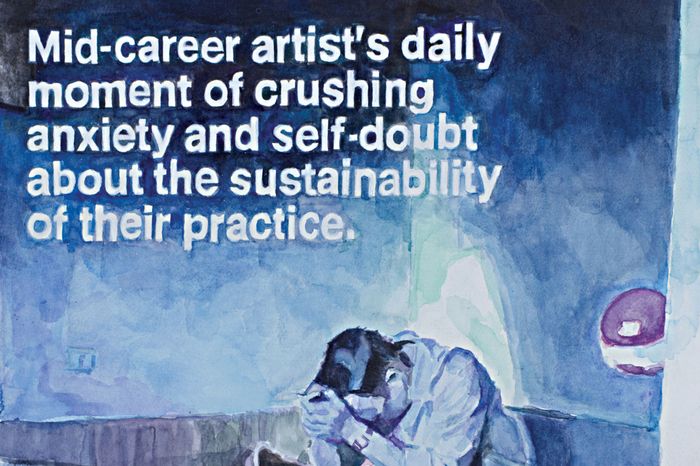Something wonderful is happening in the once and future art neighborhood of Tribeca. On the first Friday after Labor Day, these blocks were populated with crowds of artists and art lovers, all drawn by the siren song of possibility. But the smell of money, hustling collectors, and deal-makers was nowhere to be found. Instead, the air was filled with a feeling that’s been hard to come by for some time: hope. A batch of galleries opened for the very first time that night. Others had been there for a while. Many have come looking for new homes, trying to escape the alienating slew of High Line tourists and the costly rents of Chelsea.
Can a claim be staked here? Against all odds, can New York have a good art neighborhood with a walkable density of galleries? Galleries with wooden floors, flaws, and funny footprints, which are more like where artists actually make art than all those perfect, concrete-floored slick showrooms? And, unlike Chelsea and Upper East Side and elsewhere, Tribeca spaces come with basements for storage. This is a big deal when such space can cost a fortune all by itself and is often impossible to come by. “The fabulous old architecture, the feel of the neighborhood, subway accessibility, and lower prices make Tribeca a wonderful alternative to overdeveloped West Chelsea,” says Jonathan Travis, a partner of Redwood Property Group. “It’s like the old Soho scene but with a weird renewed energy.”
As always with New York, some of these opportunities were born of tragic and dispiriting circumstances. Numerous Tribeca businesses shuttered after 9/11, and retail has basically died more recently. Bruce Ehrmann, a broker for Douglas Elliman who has lived in Tribeca since 1988 (and is married to a painter), says that there are few retail tenants these days “for these classic gallery spaces with their high ceilings and Corinthian cast-iron columns.” The leases aren’t bad either — and usually ten years or longer. That will give the galleries a chance to withstand market blows and maybe grow.
For us older aficionados, it has been stunning to see, for the first time in decades, this former home to artists, artist haunts and hangouts, galleries, and seedier things come alive. Among the ghosts of Tribeca are the Mudd Club, where New Wave and punk were given life, in a building owned by an artist; Artists Space, the artist-run gallery that staged Pictures, one of the most famous shows of the late 20th century, in 1977; and the Baby Doll Lounge, where the lost, poor, and art-world wannabes worked as strippers or sat nursing loneliness and pain. (Hi.) That Friday I saw these streets teem again with love of art, eagerness, connection, and people looking for art away from the corporate noise. It was like being in New York City again.
None of this means the other art neighborhoods are bad. But this Tribeca (ish) scene doesn’t feel too cool or closed. There’s an emotional–spiritual-metaphysical warmth to the spaces, the art, the people. These galleries show lots of women artists and are finally getting better at representing artists of color. (Right now, however, the audience is still mainly white. This must change — otherwise this scene will be a dead duck before it begins.) And while it’s true that artists were priced out of this area years ago, there’s still a funkiness to the neighborhood. Which may be why Tribeca dealers seem eager to sit once again and talk with art-interested audiences, anyone — even me and you.
Alexander and Bonin
47 Walker St.
Founded in 1995, this gallery shows diverse activist artists — many known all over the world, many not and ripe for discovery.
Andrew Kreps Gallery
22 Cortlandt Alley
A crucial component of the art world, Kreps spots artists early and often, and almost no one has left it for the honeyed smell of megagalleries. A contender for the heavyweight crown.
apexart
291 Church St.
Here since 1994, this oldest of Tribeca residents is also one of the better independent not-for-profit spaces.
Bortolami
39 Walker St.
Exceptionally dynamic in terms of post-Conceptual practice — which in non-artspeak means brainy work that challenges your ideas of what art even is.
Canada
60 Lispenard St.
So many amazing painters got their start at Canada that it’s impossible to name them all. And it looks ready to set the world on fire again. Right now, see Xylor Jane — an American Bridget Riley and possibly better!
Chart
74 Franklin St.
The brand-new Chart’s third show, featuring newcomer Shona McAndrew’s radically vulnerable large-scale paintings of young women, instantly puts it on the map. Go. Thank me later.
Denny Dimin Gallery
39 Lispenard St.
An international array of artists; many of them women and artists of color.
The Drawing Center
35 Wooster St.
Under new director Laura Hoptman, this long-dormant institution is rising again.
James Cohan
48 Walker St.
This stalwart gallerist is always presenting on-point, forward-looking exhibitions.
Jeffrey Deitch
18 Wooster St.
Nobody does production, hot product, jazzy art, and wild shows better than this legendary gallerist.
The Journal Gallery
45 White St.
Focused shows of lesser-known artists, always exciting and speaking to the moment.
Kaufmann Repetto
55 Walker St.
Consistently finding artists who move to their own beat and seem to change the tempo of the moment. Right now, its Lily van der Stokker installation takes you to the heart of the medical Establishment and home cures.
Kerry Schuss
73 Leonard St.
A jack-of-all-trades and master of a few, Schuss is a visionary devoted to self-taught and outsiders, as well as contemporary art.
Luhring Augustine
17 White St.
After opening in Chelsea in 1998 and Bushwick in 2012, it’ll be adding a third spot on White Street next year, which will only make things better.
Monica King Contemporary
39 Lispenard St.
Longtime pro, Monica King, brings her smarts and eye for new art to finally fly solo.
Ortuzar Projects
9 White St.
A project space delving into the captivating canon of artists who are lesser known, overlooked, and coming up.
PAGE (NYC)
368 Broadway, #511
An intimate space that reminds us of the wonderful teeny upstairs galleries of the past.
Patrick Parrish
50 Lispenard St.
An emporium of old photos of moon landings, fine furniture, and lots of wild contemporary designers.
Peter Freeman, Inc.
140 Grand St.
Rediscoveries, back-shelf artists, older art stars, and outsiders galore.
Postmasters
54 Franklin St.
Impresario Magda Sawon has discovered numerous names but has been off the radar since moving to Tribeca six years before everyone else. Expect that to change soon.
P.P.O.W.
20 Cortlandt Alley
Perhaps the most activist small-big DIY downtown gallery of the last 40 years. Coming next year. Boom!
Queer Thoughts
373 Broadway
Best gallery name in Tribeca; this teeny office space is all about pushing political boundaries with great work.
R & Company
64 White St.
Devoted to design, this outfit features killer shows of every kind: right now, an awesome array of chairs.
Team Gallery
83 Grand St.
You want to see into the future and test your taste? That’s what I do every time I go to a José Freire gallery; he’s been in continual business since the old East Village days of the 1980s.
*A version of this article appears in the September 16, 2019, issue of New York Magazine. Subscribe Now!


